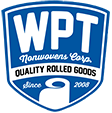WPT Nonwovens Is known as the US source for a variety of fiber types including the highest quality virgin polyester and domestically sourced, premium medical-grade bleached cotton. Our line also includes rayon and custom blends to create the right nonwovens for virtually any application. Our offerings do not end with a diverse selection of fibers…. Read more »
Posts Categorized: Nonwoven Fabrics
The One Stop Source for Nonwovens
As an experienced and fully equipped U.S. producer of high quality nonwovens, WPT Nonwovens is your one stop source for nonwoven material. Comprehensive Range of Nonwovens Materials, Treatments, & Finishing Processes We have a broad range of fiber types including the highest quality virgin polyester, bicomponent fibers, and domestically sourced certified organic cotton. We also… Read more »
Find the Right Nonwovens Supplier – Your Business Depends on It
Finding dependable suppliers is critical in manufacturing. You can have the most efficient processes and the most talented team in place, but if you do not have a secure supply chain for materials, your productivity can come to a halt. All too often, purchasers make a supplier decision based solely on price. Choosing a dirt… Read more »
Bicomponent Nonwovens offer Advantages for a Wide Range of Products
Convenient and cost-effective, bicomponent nonwovens continue to grow in popularity as the versatile choice for a diverse range of products. Nonwovens manufacturers have been able to use a variety of treatment options and materials to impart desired characteristics for a given product application. Nonwoven materials are developed for strength, stretch, and softness. Functional characteristics can… Read more »
Securing Your Supply Chain with a US Nonwovens Supplier
Recent events have brought to light important supply chain issues in the global economy. It is extremely important to have reliable suppliers as well as a contingency plan for dealing with any number of risks involved with your supply chain. WPT Nonwovens recently experienced this first hand, when answering the call for face mask production…. Read more »
Hydrophilic Nonwovens: The Soft, Absorbent & Water Friendly
When a product requires the characteristics of softness and absorbency, hydrophilic nonwovens provide a cost efficient option that delivers optimal performance. Hydrophilic nonwovens attract and retain water, and are used for products that are made for absorbing liquids, but must remain strong and durable. WPT Nonwovens develops hydrophilic nonwoven material in polyester, rayon, cotton, and… Read more »
Your U.S. Source for Certified Organic Cotton Nonwovens
Consumer trends indicate the demand for environmentally responsible, clean, and sustainable products is growing at a significant rate. In 2018, the U.S. organic market reached a record $52.5 billion, representing a 6.3 percent increase from the previous year. Much of this growth has been driven by the demand for items made with nonwoven fabrics, such… Read more »
Nonwovens Offer Ideal Characteristics for Personal Care Wipes
Personal care wipes represent a growing market as product options expand to include baby care, personal hygiene, cosmetic wipes, medicated wipes, deodorant wipes, sanitizing wipes and more. WPT Nonwovens develops nonwoven fabric for personal care wipes with a wide range of characteristics such as softness, absorbency, and strength. Our nonwovens are used to create personal… Read more »
Demand for Feminine Hygiene Nonwoven Products Grows
The personal care nonwoven market is growing by leaps and bounds everyday, as more and more people demand safe, convenient, and affordable healthcare products. Disposable female health and hygiene products are a large part of this growing demand. Ongoing product innovations are fueling this continuous market growth. WPT Nonwovens is supplying manufacturers who are answering… Read more »
From Fiber to Finished Goods – WPT Nonwovens Meets Your Needs
WPT Nonwovens offers a wide range of fiber types including the highest quality virgin polyester, bicomponent fibers, and domestically sourced certified organic cotton. We also offer rayon and custom blends to create the superior nonwovens to meet specific application needs. Advanced technology and equipment capabilities allow us to develop nonwovens using a wide range of… Read more »
